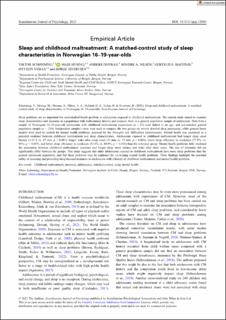| dc.contributor.author | Schønning, Viktor | |
| dc.contributor.author | Hysing, Mari | |
| dc.contributor.author | Dovran, Anders | |
| dc.contributor.author | Nilsen, Sondre Aasen | |
| dc.contributor.author | Hafstad, Gertrud Sofie | |
| dc.contributor.author | Vedaa, Øystein | |
| dc.contributor.author | Sivertsen, Børge | |
| dc.date.accessioned | 2023-09-28T11:29:19Z | |
| dc.date.available | 2023-09-28T11:29:19Z | |
| dc.date.created | 2023-09-20T10:40:11Z | |
| dc.date.issued | 2023 | |
| dc.identifier.issn | 0036-5564 | |
| dc.identifier.uri | https://hdl.handle.net/11250/3092698 | |
| dc.description.abstract | Sleep problems are an important but understudied health problem in adolescents exposed to childhood maltreatment. The current study aimed to examine sleep characteristics and insomnia in a population with maltreatment history and compare them to a general population sample of adolescents. Data from a sample of Norwegian 16–19-year-old adolescents with childhood maltreatment experiences (n = 62) were linked to an age- and sex-matched general population sample (n = 238). Independent samples t tests were used to compare the two groups on several detailed sleep parameters, while general linear models were used to control for mental health problems, assessed by the Strengths and Difficulties Questionnaire. Mental health was examined as a potential mediator between childhood maltreatment and sleep characteristics. Adolescents exposed to childhood maltreatment had longer sleep onset latency (1:15 h vs. 47 min, p < 0.001), longer wake after sleep onset (34 min vs. 15 min, p < 0.003), lower sleep efficiency in weekdays (77.8%, vs. 85%, p < 0.007), and lower sleep efficiency in weekends (81.8% vs. 88.9%, p < 0.001) than the reference group. Mental health problems fully mediated the association between childhood maltreatment exposure and longer sleep onset latency and wake after sleep onset. The rate of insomnia did not significantly differ between the groups. This study suggests that older adolescents exposed to childhood maltreatment have more sleep problems than the general adolescent population, and that these problems may be explained by co-existing mental health problems. These findings highlight the potential utility of assessing and providing sleep-focused treatment to adolescents with a history of childhood maltreatment and mental health problems. | en_US |
| dc.language.iso | eng | en_US |
| dc.publisher | Wiley | en_US |
| dc.rights | Navngivelse-Ikkekommersiell 4.0 Internasjonal | * |
| dc.rights.uri | http://creativecommons.org/licenses/by-nc/4.0/deed.no | * |
| dc.title | Sleep and childhood maltreatment: A matched-control study of sleep characteristics in Norwegian 16–19-year-olds | en_US |
| dc.type | Journal article | en_US |
| dc.type | Peer reviewed | en_US |
| dc.description.version | publishedVersion | en_US |
| dc.rights.holder | Copyright 2023 The Author(s) | en_US |
| cristin.ispublished | true | |
| cristin.fulltext | original | |
| cristin.qualitycode | 1 | |
| dc.identifier.doi | 10.1111/sjop.12960 | |
| dc.identifier.cristin | 2176908 | |
| dc.source.journal | Scandinavian Journal of Psychology | en_US |
| dc.identifier.citation | Scandinavian Journal of Psychology. 2023. | en_US |

